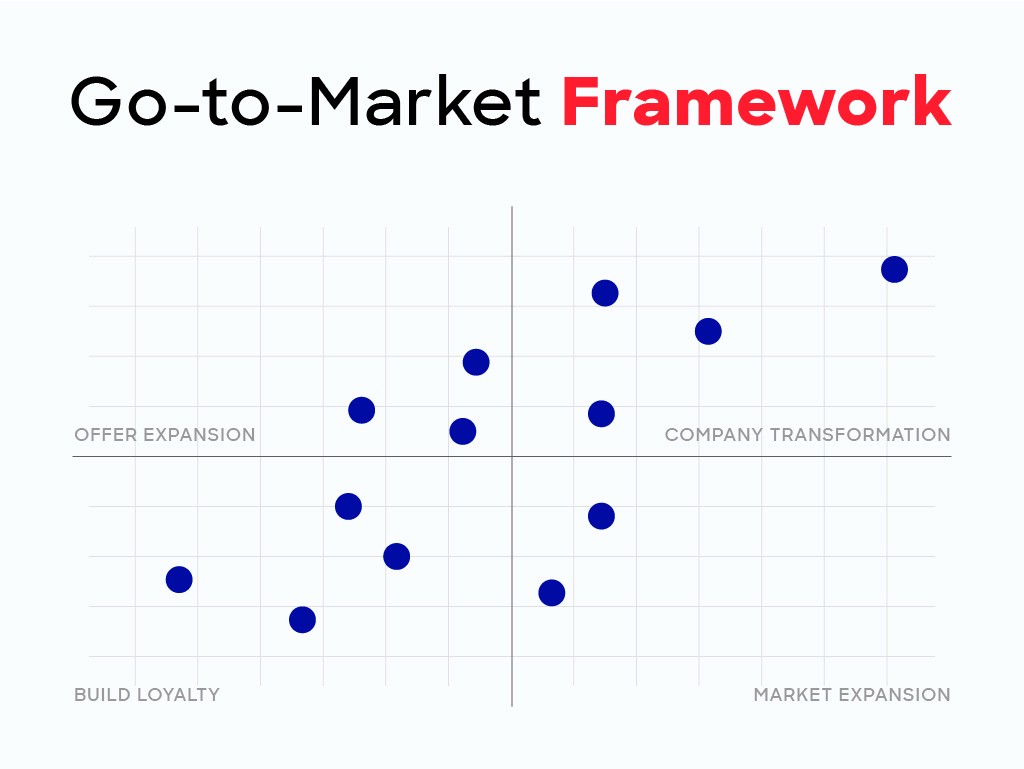Today, businesses across the country are scrambling to adapt, doing everything they can to rework their operating models in weeks and months, not years.
Even those at the top are always at risk. In 12 years, half the companies on the S&P 500 may fall off that list, according to industry research. Disruption and uncertainty are inevitable in these times, which is why a solid go-to-market plan is critical to address the unique stage and goals of any given company.
So what components make up this effort? ZoomInfo has identified four areas — or quadrants — that together create a framework for a successful go-to-market approach:
Build loyalty.
Offer expansion.
Company transformation.
Market expansion.

In this piece, we’ll briefly give an overview of these areas, with future articles delving deeper into the details.
Build Loyalty
According to HubSpot research, 93% of consumers will be repeat buyers at companies with excellent customer service.
With stakes that high, it is perhaps ironic that the early steps of building customer loyalty start with the figurative eyes and ears of a company.
“It’s imperative to continually listen to what customers are saying, putting yourselves in the customers’ shoes and thinking of ways to better enable them,” Craig Williams, chief information officer at networking software company Ciena, told IDG Connect.
It’s at least five times more expensive to bring in a new customer versus retaining an existing buyer.Forbes
In turn, customers who are loyal and dedicated to a brand are more likely to enjoy buying from a company. Notably, the pandemic has shown that companies who’ve managed to grow almost cult-like followings are more adaptable to change and more prepared to tailor offerings when the market shifts around them.
Consider these points:
Creating a customer loyalty program to motivate repeat business is a solid step to boost up allegiance. Further, encouraging positive user reviews of a product serves up testimonials that often play strongly with other buyers.
Offer Expansion
Broadening what a company offers — whether it’s a new product, additional features, or technology integrations — brings in more buyers. Even during economic uncertainty, opportunities exist with new product development.
“If your competitors suspend product development and you don’t, you have a great chance to either catch up with them or further your lead in the market,” wrote Carl Erickson, founder Atomic Object, a custom software developer.
“If your competitors suspend product development and you don’t, you have a great chance to either catch up with them or further your lead in the market.”
— Carl Erickson, founder, Atomic Object
When new products and expanded features sync with market need, they will likely generate additional revenue from customers. Doing so may also offset declines in aging products a company sells.
Note these aspects:
The success of offer expansion can increase if companies conduct a competitive analysis of the strengths and weaknesses of other products in the market. Customer interviews are also beneficial.
Market Expansion
In March 2020, TentCraft — a company that manufactures custom tents for events like festivals and concerts — got hit hard by the spreading pandemic. TentCraft’s core customers stopped buying.
But company president and founder Matt Bulloch saw an opportunity in a new market: outdoor tents for drive-up COVID-19 testing. “I told our employees we are going to completely retool the company to support the healthcare system,” Bulloch said. “There was only one problem: We’ve never actually sold to hospitals.”
“I told our employees we are going to completely retool the company to support the healthcare system.” — Matt Bulloch, president and founder, TentCraft
Using data culled from ZoomInfo’s sales intelligence platform, TentCraft was able to steer into new areas of the company’s total addressable market. This concept represents the full amount of companies or consumers that could become customers or the total revenue possible for a product to generate.
Breaking into a new market can increase revenues while also building a company’s recognition and reputation. Meanwhile, buyers who are not familiar with products or services can benefit from market expansion as a company increases its reach.
Think about these details:
To expand in new markets, an old strategy is helpful: develop ideal customer profiles based on available data to focus on those most likely to convert. Other key data includes accurate contact information for top prospects and buying signals from potential customers interested in a product.
Company Transformation
Even for top companies, the market can be unpredictable; one day a rock-star firm is riding high, yet by the next decade it could be gone.
“The 33-year average tenure of companies on the S&P 500 in 1964 narrowed to 24 years by 2016 and is forecast to shrink to just 12 years by 2027,” according to research from Innosight, a business strategy consultant.
“The turbulence points to the need for companies to embrace … transformation, to focus on changing customer needs, and other strategic interventions,” Innosight added.
Company transformation is a fundamental change in how a firm conducts business or sells its products. This evolution occurs because of an acquisition, new innovation, a shift in customer demand, or even an unexpected upheaval in the economy or society. An opportunity to outpace competitors often is a prime motivation for business transformation, as is the potential to fill a void in a market.
An opportunity to outpace competitors often is a prime motivation for business transformation, as is the potential to fill a void in a market.
Such transformation benefits buyers, as it can exposeexisting customers to new products they were not aware of and bring a new audience to a company’s product line.
The following points explain the concept briefly:
Key metrics: Cross-selling revenue, partner reselling rates, and investments in new technology related to product sales.
Job titles involved: Executives of business strategy, growth, and business transformation.
Technology: Automation platforms, machine learning, analytics software, and cloud systems.
Go-to-market plays: Upsell campaigns, cross-sell campaigns, service-level agreements between departments, and rebranded product launches.
Business transformation moves more smoothly if marketing and sales teams can cooperate easily without departmental borders impeding efforts — the 50-cent phrase “breaking down silos” comes to mind. Also, an agile approach to changes allows companies to make adjustments quicker.
Framework Sets Go-to-Market Direction
In this era of economic and social uncertainty, go-to-market plans become even more important given the hurdles are higher — or even changing — for businesses to survive.
A company’s goals in loyalty, product expansion, transformation, or new markets can be mapped out ahead of time within a framework that makes go-to-market motions smoother.
Follow our go-to-market series. In our next article, we talk about moving from a go-to-market framework to strategy.

